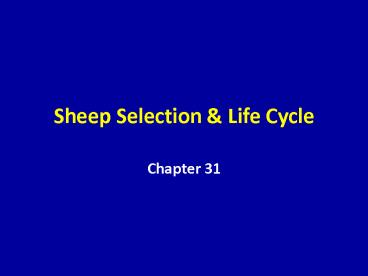Sheep Selection PowerPoint PPT Presentation
1 / 21
Title: Sheep Selection
1
Sheep Selection Life Cycle
- Chapter 31
2
Breeding Sheep
- Reproduction
- Seasonally polyestrus
- Breed in the fall (most breeds)
- Nonseasonally polyestrus
- Breed in the fall and spring
3
Breeding Sheep
- Reproduction
- Long breeding season (estrus late summer to
midwinter) - Rambouillet, Merino, Dorset
- Intermediate breeding season (late Aug to early
winter) - Suffolk, Hampshire, Columbia, Corriedale
- Short breeding season (early fall to late fall)
- Southdown, Cheviot, Shropshire
4
Breeding Sheep
- Reproduction
- Puberty is reached at 5 to 12 mo
- Average estrus cycle is 16 d
- Estrus is 30 h
- Gestation is 147 d
- Lambing rate varies within and between breeds
- Keep replacements from ewes that have high
lambing rates - Rams should have a breeding soundness exam
- Motility, mobility, Mortality
5
Breeding Sheep
- Reproduction
- Other factors affecting lambing rate
- Selection Crossbreeding
- Crossbreed ewes are more likely to conceive
- Age
- Mature ewes are more likely to conceive
- Environment
- Light, temperature, and humidity affect
reproduction in sheep - Respond to decreased daylight
- More ewes in estrus higher conception rates
- Sperm counts decrease in hot weather
6
Breeding Sheep
- Reproduction
- Other factors affecting lambing rate
- Health
- Disease, parasites, lack of feed, imbalanced
ration - Sheep in moderate body condition are more likely
to conceive than fat ewes - Estrus Synchronization and AI
- Hormones can be used to synchronize or bring ewes
into estrus - AI is used, but much more difficult than beef and
swine - Estrogen in Feeds
- High estrogen in feed low fertility
7
Breeding Sheep
- Breeding Season
- Handmated
- Teaser rams are needed to detect ewes in heat
- Pasture mated
- Tagging Ewes (removing wool from dock and vulva)
- Increases lamb percentages
- Ewe should be checked 2x / d for heat
- Usually ovulate at the end of the 30 h estrus
- Detecting the sire
- Paint on the breast of the ram
- Paint color should change every 16 or 17 d
- Goal breeding season to last 40 d
8
Ewe Production Cycle
Breed (Sept.-Nov.)
Spring Breeding???
5 mo. Gestation
Shearing ???
Cull (20-25)
Lambing (Jan. April)
9
Breeding Sheep
- Purebred Breeder
- Goal to make genetic changes in highly heritable
and economically important traits
10
Breeding Sheep
- Purebred Breeder
- Highly heritable traits
- Mature body size, yearling type score, face
cover, skinfolds, clean fleece yield, yearling
staple length, gestation length, ribeye area, fat
weight, and retail cut weight
11
Breeding Sheep
- Purebred Breeder
- Moderately heritable traits
- Birth weight, 90-d weight, rate of gain, neck
folds, grease fleece weight, fleece grade,
lambing date, milk production, carcass length,
and bone weight
12
Breeding Sheep
- Purebred Breeder
- Low heritability traits
- Weaning type score, weaning condition score,
multiple births, number of lambs weaned, fat
thickness over loin, carcass weight per day of
age, carcass grades, and dressing percentage
13
Breeding Sheep
- Commercial Breeder
- Important when determining a breeding system
- What are the available pasture and management
resources? - What is the desired income percentage from the
sale of lambs versus wool? - What are the potential benefits from heterosis?
- How can breed differences best be utilized to
meet the breeding and marketing goals of the
flock? - What is the anticipated season of marketing?
- How large is the flock?
14
Breeding Sheep
- Terminal Crossing
- Most market lambs are crossbred
- Maximum heterosis
- Combine meat and mother breeds
- Three-breed Terminal Crossbreeding
- Valuable when fine-wool is important
- Australia- Merino wool
15
Inherited Abnormalities
- Cryptorchidism
- Single recessive
- Cull rams that sire these lambs
- Dont utilize cryptorchid rams
- Dwarfism
- Recessive and lethal
- Cull ewes and rams that sire dwarf offspring
- Entropion (turned-in eyelids)
- Keep records
- Inheritance is unknown
16
Inherited Abnormalities
- Overshot or parrot mouth
- Lower jaw is too short
- Cull breeding stock
- Undershot
- Lower jaw is too long
- Cull breeding stock
- Rectal prolapse
- Common in black-face sheep
- Due to inheritance and environment
- Hot rations and lush pastures
- Do not keep for breeding stock
17
Inherited Abnormalities
- Skinfolds, open-faced, closed-faced and wool
blindness - Inherited
- Select against traits
- Spider Syndrome
- Severe skeletal deformity in Suffolk
- Outward bending of the forelimbs from the knees
- Select against
18
Callipyge
- Found in many breeds
- Dorset, Solid Gold
- Increased muscle mass
- Leaner, higher dressing percents, heavier muscled
- Meat
- TOUGH!
- Work to improve tenderness
- Potential to increase profits for producer???
19
(No Transcript)
20
Booroola Merino
- Merino Breed
- Higher production of offspring per birth
- Fine wool
- Offspring have poor performance
21
- Chapter 31 Sheep Breeding
- Understand how reproduction is different in sheep
compared to other species. - What factors affect reproduction?
- Know how heritable traits are (high, moderate,
low). - What should be considered when designing a
breeding program? - Know the different types of inherited
abnormalities. - Understand callipyge.

